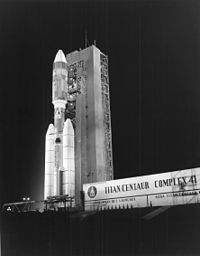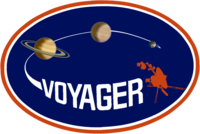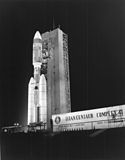Titan 3E
| Rodzina rakiet nośnych Titan | |
| Producent | |
|---|---|
| Koszt wystrzelenia | 72,5 mln USD (wg kursu z 1974) |
| Data pierwszego startu | 11 lutego 1974 |
| Data ostatniego startu | 5 września 1977 |
| Statystyki | |
| Wszystkie starty | 7 |
| Udane starty | 6 (86%) |
| Nieudane starty | 1 |
| Zdolność wynoszenia | 15 400 kg na LEO, |
| Siła ciągu przy starcie | 10 586,80 kN |
| Wymiary | |
| Długość | 48,0 m |
| Średnica | 3,05 m |
| Masa całkowita | 632 970 kg |
| Stopnie rakiety | |
| Stopień 0. | |
| Stopień 1. | Titan 3A-1 |
| Stopień 2. | Titan 3A-2 |
| Stopień 3. | |
| Stopień 4. | Star-37E (opcjonalny) |
Titan 3E – amerykańska rakieta nośna budowana przez spółkę Martin Marietta (obecnie Lockheed Martin), a także pierwsza rakieta Titan wyposażona w stopień Centaur, dotychczas używany w rakietach Atlas. Używana była do wysyłania sond międzyplanetarnych.
Starty
| Data/Godzina (GMT) | S/N | Ładunek | Zdjęcie (opcjonalne) | Ocena | Komentarz | |
|---|---|---|---|---|---|---|
| Titan | Centaur | |||||
| 11 lutego 1974 13:48:02 | 23E-1 | TC-1 | Sphinx, Viking Dynamic Simulator | Start nieudany | Awaria turbopompy ciekłego tlenu w stopniu Centaur | |
| 10 grudnia 1974 07:11:02 | 23E-2 | TC-2 | Helios 1 |  | Start udany | |
| 20 sierpnia 1975 21:22:00 | 23E-4 | TC-4 | Viking 1 |  | Start udany | |
| 9 września 1975 18:39:00 | 23E-3 | TC-3 | Viking 2 | Start udany | ||
| 15 stycznia 1976 05:34:00 | 23E-5 | TC-5 | Helios 2 | Start udany | ||
| 20 sierpnia 1977 14:29:44 | 23E-7 | TC-7 | Voyager 2 |  | Start udany | |
| 5 września 1977 12:56:01 | 23E-6 | TC-6 | Voyager 1 |  | Start udany | |
Bibliografia
- Mark Wade: Titan IIIE (ang.). W: Encyclopedia Astronautica [on-line]. [dostęp 2017-06-20].
- Jonathan McDowell: Launchlog (ang.). W: Jonathan's Space Home Page [on-line]. [dostęp 2014-05-31].
Media użyte na tej stronie
Viking 1 was launched by a Titan/Centaur rocket from Complex 41 at Cape Canaveral Air Force Station at 5:22 p.m. EDT to begin a half-billion mile, 11-month journey through space to explore Mars. The 4-ton spacecraft went into orbit around the red planet in mid-1976.
Lift-off of Gemini-Titan 11 (GT-11) on Complex 19. The Gemini 11 mission included a rendezvous with an Agena target vehicle.
The Voyager 1 aboard the Titan III/Centaur lifted off on September 5, 1977, joining its sister spacecraft, the Voyager 2, on a mission to the outer planets.
The Voyager 2 aboard Titan III-Centaur launch vehicle lifted off on August 20, 1977. The Voyager 2 is a scientific satellite that studied outer planets Jupiter, Saturn, Uranus, and Neptune.
Team Vandenberg launched a Titan IV-B rocket from Space Launch Complex 4 East on August 17, 2000. The rocket carried a National Reconnaissance Office satellite into orbit. "The 30th Space Wing, Space and Missile Center, NRO and Lockheed Martin Aerospace have worked together to build upon our legacy of success," said Col. Steve Lanning, 30th Space Wing commander and spacelift commander for the mission. "This marks the 1,800th launch from Vandenberg. We have built a solid foundation for government and commercial space launches from here for years to come." Payload-booster separation successfully occurred at 4:54.15 p.m.
Mission logo for Voyager Program









